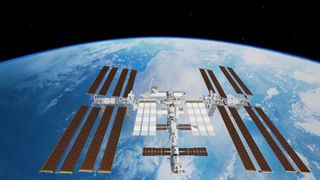Russia will withdraw from the ISS as soon as 2025
The space station faces a logitistical "nightmare" if it is to stay operational.

The head of Roscosmos, Russia's state-run space agency, announced Tuesday (July 26) that Russia intends to withdraw from the International Space Station (ISS) after its current commitment expires at the end of 2024.
Yuri Borisov, who was appointed head of Roscosmos several weeks ago, made the announcement in a meeting with Russian President Vladimir Putin.
"The decision to leave the station after 2024 has been made," Borisov said. "I think that by this time we will start putting together a Russian orbital station," he added, referring to a plan to build an exclusively Russian space station called the Russian Orbital Service Station, first proposed in 2021.
This is not the first time Roscosmos has signaled its intention to withdraw from the ISS after 2024; Borisov's predecessor, Dmitry Rogozin, made similar claims in June 2021 (and again in April and May 2022), citing the United States' economic sanctions on Russia as the main reason. Western sanctions on Russia have increased following the nation's invasion of Ukraine in February.
NASA says it has not received any formal notice about Russia's withdrawal, according to The New York Times. Though Russia's current commitment ends at the end of 2024, NASA hopes to extend the ISS' operations through 2030.
The first module of the ISS was launched in 1998, and astronauts have lived there since November 2000. The station is a joint effort among the U.S., Russia, Canada, Europe and Japan.
Russia's withdrawal could significantly complicate the space station's future operations, science historian Jordan Bimm told USA Today.
Sign up for the Live Science daily newsletter now
Get the world’s most fascinating discoveries delivered straight to your inbox.
"Practically, it could be a nightmare depending on how hard Russia wanted to make it for NASA and its remaining partners," Bimm said.
The ISS consists of two interconnected sections: one run by NASA and the other by Russia. An array of solar panels on the NASA section generates much of the station's power. The Russian section, meanwhile, provides propulsion to periodically push the ISS into a higher orbit and prevent it from falling to Earth. Should Russia withdraw, the remaining partner nations will need to implement some other means of propulsion to keep the ISS safely in orbit.
"The withdrawal will take some time," Pavel Luzin, a Russian military and space analyst, told The New York Times. "Most likely, we need to interpret this as Russia's refusal to extend the station's operation up until 2030."
Earlier this year, NASA announced a new plan for decommissioning the aging space station in January 2031, by allowing the ISS to tumble into a remote corner of the Pacific Ocean known as Point Nemo. NASA has signed agreements with three private companies to launch several new commercial space stations by the late 2020s.
Originally published on Live Science.

Brandon is the space/physics editor at Live Science. His writing has appeared in The Washington Post, Reader's Digest, CBS.com, the Richard Dawkins Foundation website and other outlets. He holds a bachelor's degree in creative writing from the University of Arizona, with minors in journalism and media arts. He enjoys writing most about space, geoscience and the mysteries of the universe.
